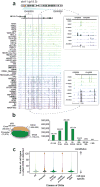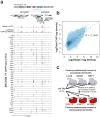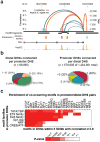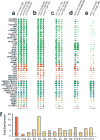The accessible chromatin landscape of the human genome
- PMID: 22955617
- PMCID: PMC3721348
- DOI: 10.1038/nature11232
The accessible chromatin landscape of the human genome
Abstract
DNase I hypersensitive sites (DHSs) are markers of regulatory DNA and have underpinned the discovery of all classes of cis-regulatory elements including enhancers, promoters, insulators, silencers and locus control regions. Here we present the first extensive map of human DHSs identified through genome-wide profiling in 125 diverse cell and tissue types. We identify ∼2.9 million DHSs that encompass virtually all known experimentally validated cis-regulatory sequences and expose a vast trove of novel elements, most with highly cell-selective regulation. Annotating these elements using ENCODE data reveals novel relationships between chromatin accessibility, transcription, DNA methylation and regulatory factor occupancy patterns. We connect ∼580,000 distal DHSs with their target promoters, revealing systematic pairing of different classes of distal DHSs and specific promoter types. Patterning of chromatin accessibility at many regulatory regions is organized with dozens to hundreds of co-activated elements, and the transcellular DNase I sensitivity pattern at a given region can predict cell-type-specific functional behaviours. The DHS landscape shows signatures of recent functional evolutionary constraint. However, the DHS compartment in pluripotent and immortalized cells exhibits higher mutation rates than that in highly differentiated cells, exposing an unexpected link between chromatin accessibility, proliferative potential and patterns of human variation.
Conflict of interest statement
The authors declare no competing interests.
Figures







Comment in
-
Genomics: users' guide to the human genome.Nat Rev Genet. 2012 Oct;13(10):678. doi: 10.1038/nrg3329. Epub 2012 Sep 7. Nat Rev Genet. 2012. PMID: 22955793 No abstract available.
References
-
- Gross DS, Garrard WT. Nuclease hypersensitive sites in chromatin. Annu Rev Biochem. 1988;57:159–97. - PubMed
-
- Gaszner M, Felsenfeld G. Insulators: exploiting transcriptional and epigenetic mechanisms. Nat Rev Genet. 2006;7:703–13. - PubMed
-
- Li Q, Harju S, Peterson KR. Locus control regions: coming of age at a decade plus. Trends Genet. 1999;15:403–8. - PubMed
-
- Heintzman ND, et al. Distinct and predictive chromatin signatures of transcriptional promoters and enhancers in the human genome. Nat Genet. 2007;39:311–318. - PubMed
Publication types
MeSH terms
Substances
Associated data
- Actions
- Actions
- Actions
- Actions
- Actions
- Actions
Grants and funding
- HHSN261200800001E/CA/NCI NIH HHS/United States
- R01 GM076036/GM/NIGMS NIH HHS/United States
- GM076036/GM/NIGMS NIH HHS/United States
- HG004563/HG/NHGRI NIH HHS/United States
- R01 MH084676/MH/NIMH NIH HHS/United States
- HG004592/HG/NHGRI NIH HHS/United States
- U54 HG004592/HG/NHGRI NIH HHS/United States
- MC_UP_1102/1/MRC_/Medical Research Council/United Kingdom
- R01 HG003143/HG/NHGRI NIH HHS/United States
- F30 DK095678/DK/NIDDK NIH HHS/United States
- U54 HG004563/HG/NHGRI NIH HHS/United States
- R01MH084676/MH/NIMH NIH HHS/United States
- P30 CA016086/CA/NCI NIH HHS/United States
LinkOut - more resources
Full Text Sources
Other Literature Sources
Molecular Biology Databases

